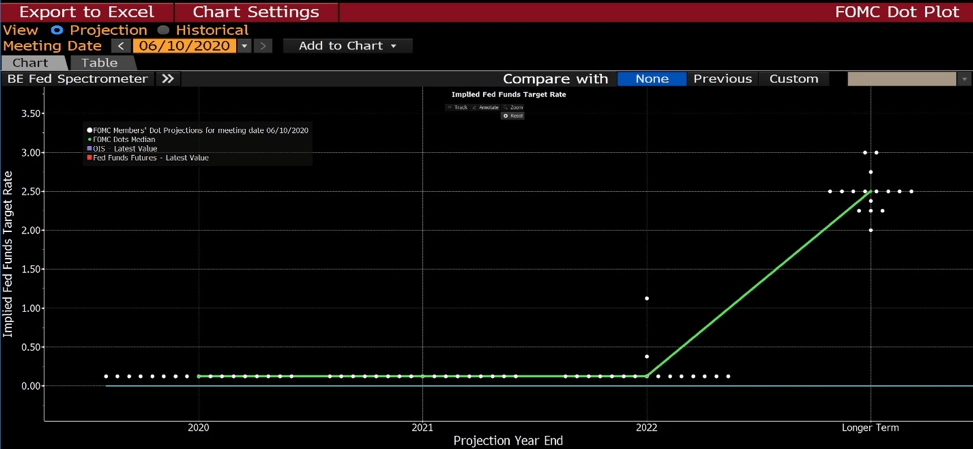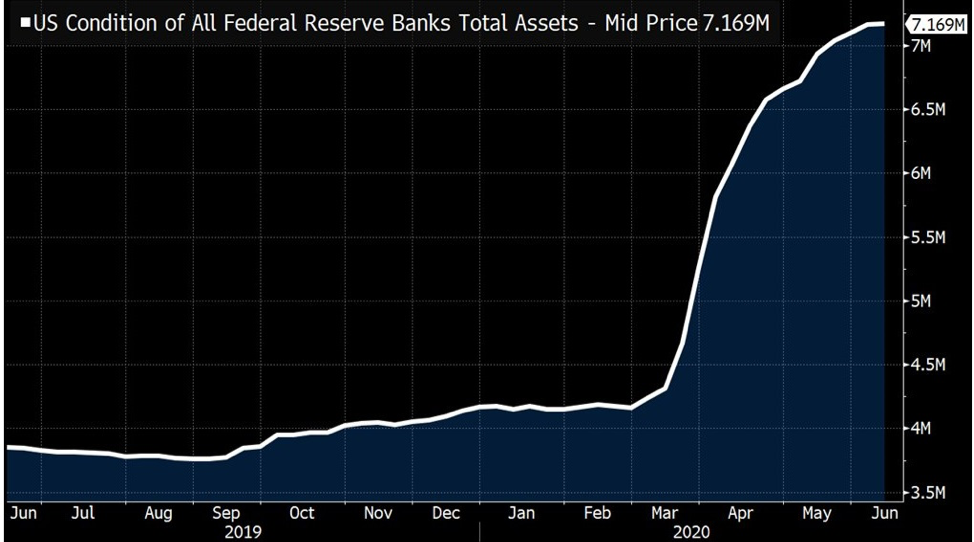Overview
The COVID-19 pandemic has triggered one of the most severe global economic downturns in decades. Policymakers around the world have taken broad measures to contain and limit the economic damage from the virus outbreak. These measures including cutting the interest rates to ultra-low levels and asset purchase programs worth trillions of dollars. While such actions are expected to inflate asset prices around the world further, what's that mean for crypto assets like Bitcoin (BTC)?
Fed funds rate to stay ultra-low at least until 2022
The COVID-led economic uncertainties have pushed the US Fed to returnto the near-zero interest rates bandwagon. The two unscheduled rate cuts in March have slashed a total of 150 basis points of the fed funds rate, making the target range of the rate to 0%-0.25%. The move made the Fed re-join its counterparts in the UK, Europe, and Japan, as part of the globally coordinated action to cushion the impact from the COVID-19 situation.
The Fed officials also provided their interest rates outlook at the June policy meeting. The latest dot plot shows that 15 of the Federal Open Market Committee (FOMC) participants didn’t expect the Fed to raise rate before 2022, while only two officials expect the central bank to increase the interest rates in 2022.
Figure 1: The US Federal Reserve’s dot plot (Source: Bloomberg)
Fed Chair Jerome Powell said in the June policy meeting statement that "The Committee expects to maintain this target range until it is confident that the economy has weathered recent events and is on track to achieve its maximum employment and price stability goals.”
With the May unemployment rate sitting at 13.3%, which is slightly lower than the record high of 14.7% in April, markets didn’t expect the number to return to the pre-COVID levels anytime soon. We are still very far away from what the Fed’s target of having the economy "on track to achieve its maximum employment." The joblessness situation could solidify the case of having near-zero rates in the coming two years.
Balance sheet expansion
On top of the ultra-low interest rates, the resumption of the asset-buying program of the Fed is another key part of the overall package to support the financial market functioning, and it’s not hard to notice the central bank’s desperation on utilizing their balance sheet as their new monetary toolto provide liquidity
On March 15, the Fed announced that it would commit to purchase at least $500 billion of Treasury securities and at least $200 billion of mortgage-backed securities.
On March 23, the Fed made the program open-ended, saying that it will “purchase the amounts needed to support smooth market functioning and effective transmission of monetary policy to broader financial conditions and the economy.”
On June 15, the Fed saidit would start to buy corporate bonds through the Secondary Market Corporate Credit Facility (SMCCF)to boost market liquidity and credit availability for large employers.Although the move is in-line with what the Fed has said, the inclusion of corporate bonds in the asset-buying program is somewhat unexpected.
With the new round of asset purchases, the Fed's balance sheet has ballooned from the pre-COVID levels of $4.1 million to over $7.1 million in mid-June.
Figure 2: Fed's balance sheet (Source: Bloomberg)
Why central banks ruffled feathers?
The interest rates are likely to remain at near-zero levels in the near future, and asset prices are expected to be boosted by asset purchasing programs (not just from the Fed but other major central banks as well). Crypto assets such as Bitcoin could get the best from both worlds.
Snowballing asset prices: When new money keeps pumping into the system,it pushes investors to look for higher-yielding assets instead of holding cash.That's because the increased money supply will devalue the currency and diminishing purchasing power. They would probably ask, where to put the money? In fact, equities and gold have been some of the beneficiaries of these easing narratives, and crypto-assets like Bitcoin could be another asset benefit from that.
Inflation vs. deflation: Unlike fiat currency where central banks can keep printingnew money as needed, Bitcoin’s supply is finite. This supply limitationgives Bitcoin an anti-inflationary property that many of the fiat currencies don’t have.In fact, Bitcoin is more like commodities like gold rather than fiat currency. Moreover, Bitcoin’s network is decentralized, offeringgreater protection to its holders. All these features make Bitcoin an ideal store of value, and the post-COVID actions from global central banks will only strengthen this narrative.
CBDC confirms Bitcoin is on the right track: CBDC has been one of the buzzwords among blockchain and crypto watchers in recent months. Countries like China have been putting in extra efforts when it comes to launching its own CBDC, and the official launch of China’s CBDC isreportedly on the horizon. While other countries and central banks have been catching up,the increasing openness and the policymakers’ attitude shift toward to a more blockchain-friendly landscapecould be a sign showing that Bitcoin is actually developing on a right direction, or else central banks around the world won’t try to adoptBitcoin’s core technology to improve the effectiveness of their monetary system.
Conclusion
At the time that the second wave of the COVID-19 pandemic seemsbecoming more threatening to the global economic recovery,global central banks including the US Fed are expected to maintain their easing narratives and policies for an extended period, and that could be one of the most important fundamental factors that could shape the narrative of the broader crypto market from the medium/long-term perspective. While markets’ expectations of the US will be maintaining the near-zero interest rates in the coming two years, these expectations could also be changedfrom time to time. That’s why macro watchers probably don’t want to miss the latest developments of the COVID-19 situation, and the recovery of the real economy.
This material should not be taken as the basis for making investment decisions, nor be construed as a recommendation to engage in investment transactions. Trading digital assets involves significant risk and can result in the loss of your invested capital. You should ensure that you fully understand the risk involved and take into consideration your level of experience, investment objectives and seek independent financial advice if necessary.
Recommended Content
Editors’ Picks
PENDLE price soars 10% after Arthur Hayes’ optimism on Pendle derivative exchange

Pendle (PENDLE) price is among the top performers in the cryptocurrency market today, posting double-digit gains. Its peers in the altcoin space are not as forthcoming even as the market enjoys bullish sentiment inspired by Bitcoin (BTC) price.
Ethereum shows signs of a potential rally as suspected Justin Sun wallet buys heavily

Ethereum's (ETH) recent price movement hints at a potential rally despite ETH ETPs recording outflows. The recent price improvement follows the fourth Bitcoin halving and a suspected Justin Sun wallet purchasing large numbers of ETH.
Floki poised for growth after listing on Revolut

Floki's (FLOKI) team announced in an X post on Monday that the meme coin would be listed on the popular neobank and Fintech platform Revolut. Floki could rise further following key partnerships to boost retail usage.
Jupiter DEX second Launchpad vote concludes, JUP price rises 5%

Jupiter, a Solana-based decentralized exchange (DEX) has completed the second launchpad (LFG) vote to identify the two projects that will debut on its platform. On March 30, the aggregator network had unveiled its Core Working Group (CWG) budget proposal voting.
Bitcoin: BTC post-halving rally could be partially priced in Premium

Bitcoin (BTC) price briefly slipped below the $60,000 level for the last three days, attracting buyers in this area as the fourth BTC halving is due in a few hours. Is the halving priced in for Bitcoin? Or will the pioneer crypto note more gains in the coming days?

